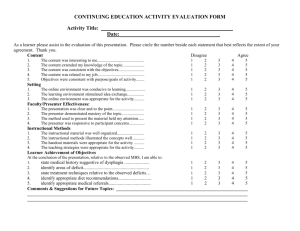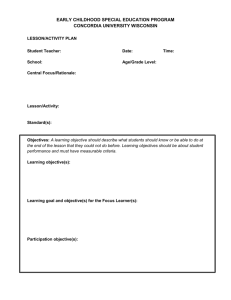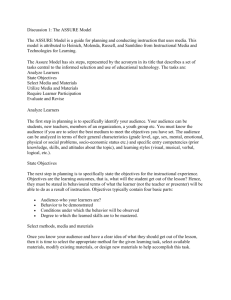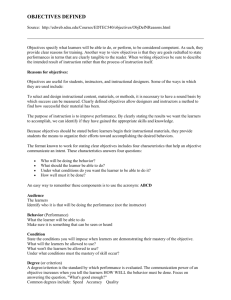Word
advertisement
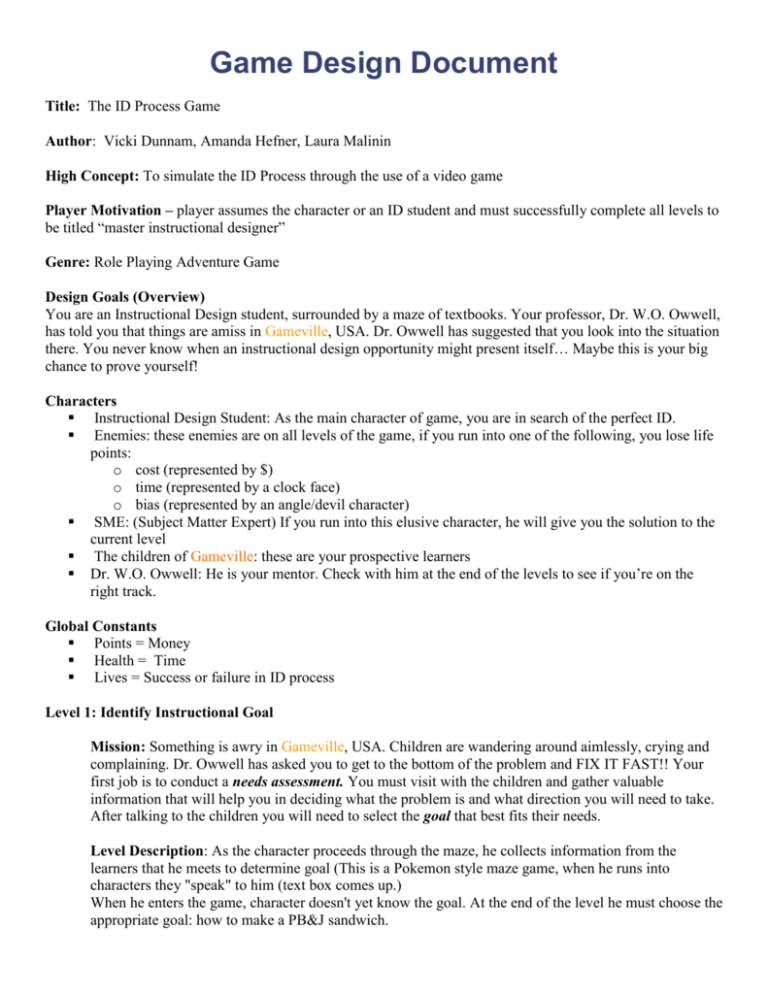
Game Design Document Title: The ID Process Game Author: Vicki Dunnam, Amanda Hefner, Laura Malinin High Concept: To simulate the ID Process through the use of a video game Player Motivation – player assumes the character or an ID student and must successfully complete all levels to be titled “master instructional designer” Genre: Role Playing Adventure Game Design Goals (Overview) You are an Instructional Design student, surrounded by a maze of textbooks. Your professor, Dr. W.O. Owwell, has told you that things are amiss in Gameville, USA. Dr. Owwell has suggested that you look into the situation there. You never know when an instructional design opportunity might present itself… Maybe this is your big chance to prove yourself! Characters Instructional Design Student: As the main character of game, you are in search of the perfect ID. Enemies: these enemies are on all levels of the game, if you run into one of the following, you lose life points: o cost (represented by $) o time (represented by a clock face) o bias (represented by an angle/devil character) SME: (Subject Matter Expert) If you run into this elusive character, he will give you the solution to the current level The children of Gameville: these are your prospective learners Dr. W.O. Owwell: He is your mentor. Check with him at the end of the levels to see if you’re on the right track. Global Constants Points = Money Health = Time Lives = Success or failure in ID process Level 1: Identify Instructional Goal Mission: Something is awry in Gameville, USA. Children are wandering around aimlessly, crying and complaining. Dr. Owwell has asked you to get to the bottom of the problem and FIX IT FAST!! Your first job is to conduct a needs assessment. You must visit with the children and gather valuable information that will help you in deciding what the problem is and what direction you will need to take. After talking to the children you will need to select the goal that best fits their needs. Level Description: As the character proceeds through the maze, he collects information from the learners that he meets to determine goal (This is a Pokemon style maze game, when he runs into characters they "speak" to him (text box comes up.) When he enters the game, character doesn't yet know the goal. At the end of the level he must choose the appropriate goal: how to make a PB&J sandwich. Objectives and Goals: Character gets points for each learner that he speaks to. He must speak to all 4 learners to reach the end of the level. After talking to all the learners, character must decide between then goal statements to determine the one that fits best, or repeat the level and 'listen' better. Player Information: Level specific enemy: the "fuzzy goal." If the character meets this enemy, he looses all his points and has to go back to the beginning of the level. Level 2: Analyze Learners and Context Mission: Great job! You’ve identified an instructional goal to quell the chaos in Gameville. But Dr. Owwell says you’re not done yet. What do you know about the learners? You must question the children and explore Gameville. It’s your job to analyze learners and context! Level Description: Learner characteristics: Character must go around maze obstacles and talk to each "learner" in the room to gather info on who they are, then proceed to the end before time is up. Context: Character goes into a building to see that there is a kitchen with a sink, refrigerator, pantry Tools: Character opens the pantry to see that there is peanut butter, jelly, knife, paper towels… Objectives and Goals: From the comments offered by the learners interviewed by the user, the user must deduce the correct context of learning, level, learner age, and tools needed. Character must complete a checklist of the following information to complete the level: learner age, learner knowledge level, context, and available tools. Player Information: Less time to complete the level correctly = more points. Level 3: Goal Analysis Mission: Dr Owwell asks you “What would the children be doing if they demonstrated that they already knew how to make a peanut butter and jelly sandwich?” You’re not sure. You need to classify your goal using Gagne’s Domains of Learning. Dr. Owwell has provided the list; you choose the appropriate learning domain for your goal. Level Description: There is a room with a list of Gagne’s domains of Learning. Character must choose the appropriate goal type and grab it from the room. Objectives and Goals: Character will choose from Gagne's domains: verbal, intellectual, psychomotor, attitudinal, cognitive. Player Information: Verify answer with Dr. Owwell to proceed, or re-do if not correct. (Gain points for correct answer; lose points for incorrect answer.) Level 4: Task Analysis Mission: How will the children know what to do? A task list is in order! Dr. Owwell tells you that it’s always a good idea to create a flowchart. You must organize your list of tasks into flowchart form. Level Description: Character must put task items in order by picking them up from one place and dropping them off in the correct location on the flowchart so that they are in sequence. "Floor" will have a flowchart on it. Items will be boxes, diamonds, ovals with tasks required to make a peanut butter and jelly sandwich. Objectives and Goals: Character must put task items in correct order on the corresponding flowchart and consult Dr. Owwell for results. Player Information: Gain points for correct answer, lose points and start over level for incorrect answers. Level 5: Objectives Mission: A town meeting was held. You met with the children of Gameville. You were so excited to present them with a solution to their problem. But after showing them the goal statement and the task flowchart, they were still confused. They didn’t understand where the instruction was taking them. You went to Dr. Owwell for help. “You need learning objectives,” he said. So you wrote out some objectives for your instruction and brought them to him to look over. “Good objectives must have three parts: It must describe what the learner will do. It must describe the conditions of learning. And it must describe the criteria that will be used to assess the learners performance.” Your job is to sort out the good objectives from the bad. Be sure to dump the bad ones in the trash can, you don’t want them creeping back into the instruction! Level Description: A list of objectives will appear on the screen for a limited amount of time then disappear. Character must grab the bad objectives and put them in the trashcan before time runs out. Objectives and Goals: Character must grab only the bad objectives and put them in the trashcan before time runs out. When finished, character will check answers with Dr. Owwell. Player Information: Gain points for correct objectives left at the end of the level. Lose points for any bad objectives not in the trashcan, or good objectives that were mistakenly put in the trashcan. Level 6: Assessments Mission: Help! The children of Gameville need you expertise! Tests are raining down on them from above. The kids are overwhelmed. You need to shoot the assessment types that aren’t suitable for the instruction before they land on the children and knock them out! But don’t destroy the good assessments; they make the children smarter! Hint: think of the criteria component of your objective Level Description: Arcade style shooter game: Learners are walking around at the bottom of the screen. Assessment types are raining down on them from above. Objectives and Goals: Character must distinguish appropriate assessment types from inappropriate, shooting and destroying only the inappropriate types. Player Information: Lose point if a bad assessment hits a learner. Gain points for destroying a bad assessment type. Bonus points if a good assessment hits a student. Level 7: Instructional Strategy Mission: The children of Gameville are getting bored. They’ve been waiting so long for you to teach them that now they’ve lost interest. How can you get them excited about the lesson? You go to Dr. Owwell for help. “You need to develop an instructional strategy,” he says. “Look at Gagne’s nine events of instruction.” You must develop your strategy by matching your ideas with Gagne’s nine events of instruction. Level Description: “Concentration” style memory matching game. Player will click on a card to turn it over. Correct matches will disappear; incorrect matches will turn back over so that the text is hidden. Objectives and Goals: Player must match a piece of instructional strategy with Gagne’s corresponding “event of instruction.” Player Information: Must complete all the matches before time runs out, or lose points and start level over. Level 8: Media Selection Mission: The children are showing interest in the instruction, but to really grab their attention, you need to invest in some media. There are different costs associated with each type, but you have the opportunity to earn back what you spent, and more, if the instruction is really successful! Level Description: Character enters a “store” with various media systems displayed. There is a price tag associated with each media system. Character must select an appropriate media delivery system, using points to pay for the item. Objectives and Goals: Character must select the most appropriate media delivery system for the type of instruction. Player Information: Character must use points to pay for media types. Character will get bonus points back during the formative evaluation level if the SME and learners like the media delivery system. Level 9: Develop Instructional Materials Mission: Dr. Owwell says, “Your big moment has arrived. It’s time to put together the instructional materials.” You think, “Isn’t that what I’ve been doing all along?” “ Do you remember all the components that you need to include?” asks Dr. Owwell. “You’d better get started, the kids are getting anxious!” Your job is to develop and compile instructional materials. Level Description: Character enters a messy office and must search for the instructional materials. Objectives and Goals: Character must select the correct components of the rough draft and give them to Dr. Owwell before the clock runs out. Player Information: Points are accrued for each of the correct components. Incorrect components will cause loss of points. Level 10: Formative Evaluation and Revision Mission: “Where are you going?” asks Dr. Owwell. “To teach my class,” you reply. “Whoa there, not yet,” he responds, “Have you completed the formative evaluation?” Quick, you must test out the instructional material before your class is scheduled to start! Begin by finding the SME! Level Description: Character must navigate a maze to find first the SME to conduct an expert evaluation and then the learner for a one-to-one evaluation before time runs out. Objectives and Goals: Expert Review : Character must find the SME - ok or not based on correct combo of levels 7-9. If not ok, go back to level 7, if ok go find learner. One to One (learner validation): Character selects a learner to make the sandwich. If they can make it, points up, if not, points down. If successful, learner will lead the character to the small group for a field test. (Character gets bonus points if media selection is good.) If unsuccessful, character will have the option of returning to level 7 or use points to "buy" a revised draft and proceeding to the small group / field test Small Group Eval / Field test : If ok, points up, if not ok, option of returning to level 7 or use points to "buy" a revised draft and proceed to next level. Player Information the goal of the game is to complete all levels with the most points possible before the clock runs out. If the instruction needs revision you have the option of either returning to level 7 and making revisions, or remaining on the current level and “buying” a revision. Instructional Design completed and ready for implementation “Wonderful!” says Dr. Owwel, “Now your ready to present the materials to your learners.” “Let’s see how you’ve done.” Check with Dr. Owwell to see how you measure up. Level Description: Character will check with Dr. Owwell and is assigned a title based upon the number of points accrued so far. The lowest title is that of “Instructional Dunce” highest is “Novice Instructional Designer.” Objectives and Goals: Player will have game points assessed and is given the option of continuing on to the Bonus Level to earn more points and a higher title. Bonus Level: Summative Evaluation and Revision Mission: “How long have you been teaching your class?” asks Dr. Owwell. “About 6 months,” you reply. “And how are your learners doing?” “Pretty good, I think,” you respond. “They don’t seem to be so hungry all the time.” “Okay, then,” he says, “so now it’s time for the summative evaluation.” Find out how well your class is meeting the needs of the learners by conducting a summative evaluation. Start by finding the learner who has the evaluation survey. Level Description: Character must navigate a maze to find a learner, Dr. Owwell, and the results of the data test analysis before time runs out. Objectives and Goals: Expert Judgment : First character must find a learner to get the evaluation survey. Character gets bonus points for finding the student. Student tells character to look for Dr. Owwell. Next character must find Dr. Owwell for the job evaluation. Character gets bonus points for finding Dr. Owwell. Dr. Owwell tells character to find the results of the test data analysis. Field Trial: Character must find the results of the test data analysis. Character gets bonus points for finding it. Player Information: Character may reach end of the maze without finding learner and/ or Dr. Owwell. Character may reach the end of maze without finding the test data analysis. End of Game Congratulations! The children of Gameville are hungry no more! Check with Dr. Owwell for your final job evaluation. Level Description: Final points are assessed and title is awarded. Highest title possible is “Master Instructional Designer.”




